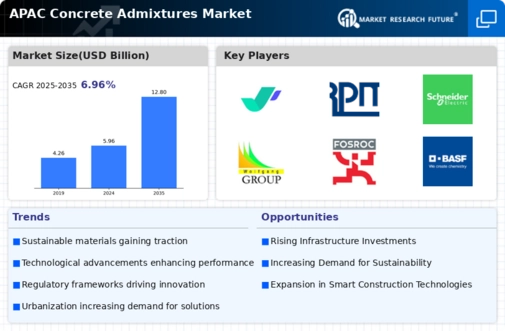Market Analysis
In-depth Analysis of APAC Concrete Admixtures Market Industry Landscape
The Asia-Pacific (APAC) Concrete Admixtures Market is witnessing dynamic changes influenced by a combination of factors, including robust construction activities, urbanization trends, infrastructure development, and the adoption of advanced construction technologies. As the region experiences rapid economic growth, there is a significant demand for high-performance concrete solutions, driving the market for admixtures. One key driver shaping the market dynamics is the increasing focus on improving the properties of concrete, such as strength, durability, and workability. Concrete admixtures, including superplasticizers, accelerators, retarders, and air-entraining agents, play a crucial role in enhancing the performance and versatility of concrete, meeting the evolving requirements of diverse construction projects.
Technological advancements are playing a pivotal role in shaping the market dynamics of concrete admixtures in the APAC region. The development of innovative admixture formulations, coupled with advancements in manufacturing processes, allows manufacturers to cater to specific project needs and address challenges related to varying environmental conditions. The integration of smart technologies, such as sensor-based admixture systems, is becoming a trend, providing real-time monitoring and optimization of concrete properties during construction. As construction practices become more sophisticated, the adoption of advanced admixtures is becoming a defining factor in the industry's competitiveness and market dynamics.
The competitive landscape is another significant factor influencing market dynamics, with several global and regional players competing to provide a diverse range of concrete admixtures. The emphasis on research and development to introduce new formulations, sustainable solutions, and cost-effective products is driving innovation in the market. Partnerships and collaborations between admixture manufacturers, construction companies, and research institutions contribute to the overall competitiveness of the APAC Concrete Admixtures Market.
Regulatory influences also play a crucial role in shaping the market dynamics of concrete admixtures in the APAC region. Governments across APAC countries are increasingly implementing building codes and standards that require the use of high-performance concrete with specific properties. This has led to a growing demand for admixtures that comply with these regulations and contribute to the development of durable and sustainable infrastructure. As regulatory frameworks evolve to address environmental concerns and enhance construction standards, the market dynamics are influenced by the industry's ability to adapt and meet these changing requirements.
Moreover, economic conditions and infrastructure investments significantly impact the market dynamics of concrete admixtures in the APAC region. Economic growth, urbanization, and increased spending on infrastructure projects drive the demand for high-quality and efficient construction materials, including concrete admixtures. The rise of smart cities and sustainable infrastructure projects further propels the market, as admixtures become essential components in the construction of modern and resilient structures.
Consumer preferences within the construction industry contribute to the market dynamics of concrete admixtures. Developers, contractors, and engineers are increasingly recognizing the benefits of using admixtures to achieve specific performance goals, reduce construction time, and enhance the sustainability of projects. As awareness grows and the construction industry seeks solutions that address both technical and environmental challenges, there is a shift in preferences toward advanced admixtures, influencing purchasing decisions and market dynamics.
Global trends, such as the push for sustainable and green construction practices, impact the market dynamics of concrete admixtures in the APAC region. The demand for eco-friendly and energy-efficient buildings aligns with the sustainable properties of certain admixtures. Manufacturers that focus on providing environmentally friendly and low-carbon footprint admixture solutions are well-positioned to capitalize on the increasing preference for sustainable construction practices in the APAC market.

















Leave a Comment